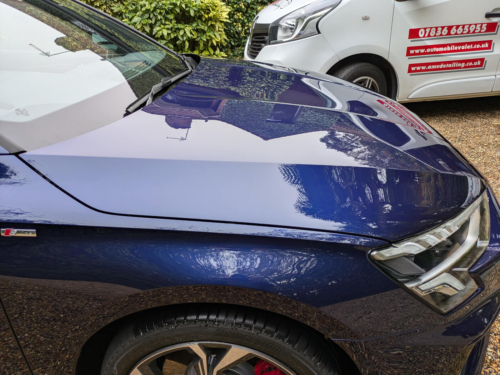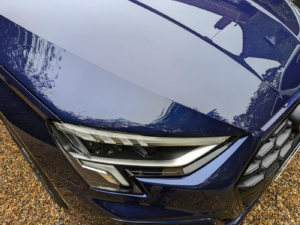A Comprehensive Guide to Machine Polishing Your Car: What’s Possible and Which Polisher to Choose

If you’ve ever wondered how professional detailers achieve that flawless, mirror-like finish on cars, the secret often lies in machine polishing. While hand polishing can certainly improve a vehicle’s appearance, using a machine polisher can take your car’s paintwork to a whole new level.
In this post, we’ll explain what machine polishing can do for your car, the different types of polishers, and which one might be best for your detailing needs.
What Is Machine Polishing?
Machine polishing involves using an electric polisher to apply abrasive compounds to a car’s paint in a controlled manner. The rotating or oscillating motion of the polishing pad helps to level the paint surface by removing a thin layer of clear coat, smoothing out imperfections, and restoring the paint’s clarity and shine.
While this technique is primarily used to remove swirl marks, scratches, and oxidation, it can also be used for paint correction and to enhance the overall depth and gloss of the finish. When done correctly, machine polishing can transform the appearance of your car, making the paint look brand new.
What Can Machine Polishing Achieve?
- Removing Swirl Marks and Scratches One of the most common reasons car owners opt for machine polishing is to remove swirl marks and minor scratches. Swirl marks are fine lines that often appear when a car is washed improperly, usually from using an abrasive towel or sponge. These marks can detract from the overall appearance of your paint, but a machine polisher can efficiently level out the surface and remove them.
- Eliminating Oxidation Over time, exposure to the sun, weather, and environmental contaminants can cause the paint to fade, resulting in dullness and a lack of shine. Machine polishing helps remove oxidized layers of paint, revealing a fresh, vibrant finish underneath.
- Improving Paint Clarity A well-polished vehicle has a deep, glossy finish that reflects light beautifully. Machine polishing removes imperfections and contaminants, improving the clarity and smoothness of the paint surface, allowing the car’s true color to shine through.
- Paint Correction Paint correction refers to the process of correcting defects in the paintwork, such as swirl marks, scratches, water spots, and more. Depending on the severity of the defects, machine polishing can correct or significantly reduce the appearance of these issues, bringing your car’s paint back to near-perfect condition.
- Enhancing the Gloss and Shine One of the most noticeable benefits of machine polishing is the significant improvement in the gloss and shine of your vehicle’s paint. By removing imperfections and creating a smoother surface, the paint will reflect light more evenly, resulting in a glossy, showroom-worthy finish.
Types of Machine Polishers
There are several types of machine polishers available, each with its unique characteristics and applications. Understanding the differences between them will help you choose the right one for your needs.
- Rotary Polishers
What They Are:
Rotary polishers use a rotating motion to spin the polishing pad at high speeds. They’re powerful tools that can quickly correct paint defects and restore the paintwork.
What They Do Best:
Rotary polishers are often preferred by professional detailers because they can remove deep scratches, oxidation, and other serious paint imperfections. They’re also more efficient when it comes to cutting through tough layers of paint, making them ideal for paint correction.
Advantages:
- Faster and more aggressive cutting action.
- Ideal for removing deep defects and heavy oxidation.
- Can achieve a high level of gloss with less time.
Disadvantages:
- Requires experience and skill to avoid damaging the paint (e.g., burning through the clear coat).
- Higher risk of leaving holograms or swirl marks if not used properly.
Best For:
Experienced detailers or those who need to tackle serious paint defects.
- Dual Action (DA) Polishers
What They Are:
Dual action polishers have a dual-motion mechanism. The pad spins while simultaneously oscillating in small circles. This less aggressive motion makes DA polishers more forgiving and easier to use compared to rotary machines.
What They Do Best:
DA polishers are incredibly versatile and can be used for both light polishing and paint correction. They’re effective at removing swirl marks, light scratches, and oxidation without the risk of damaging the paint.
Advantages:
- Easier to use for beginners due to less risk of damage.
- Can be used for both light polishing and more advanced paint correction.
- Offers a safer, more controlled polishing process.
Disadvantages:
- Takes longer to correct deeper imperfections compared to rotary polishers.
- Less aggressive cutting power, which means it might not be ideal for heavy defect removal.
Best For:
Beginner to intermediate users who want a safer, more controlled experience. Great for those looking to enhance the paint without the risk of serious damage.
- Forced Rotation (Gear-Driven DA) Polishers
What They Are:
Forced rotation polishers are similar to dual-action machines but with a twist. The pad both spins and oscillates with a forced rotational motion, giving the tool more cutting power than a standard DA polisher.
What They Do Best:
These polishers are excellent for tackling moderate to heavy paint imperfections, such as swirl marks and light scratches, while still providing the safety of a dual-action polisher. They’re often used by professionals who need to balance performance and safety.
Advantages:
- More cutting power than standard DA polishers but still safer than rotary machines.
- Effective on both light and moderate defects.
- Less risk of leaving holograms compared to rotary polishers.
Disadvantages:
- A bit more expensive than standard DA polishers.
- Can still cause damage if not used properly, though it’s less likely than with a rotary.
Best For:
Detailers or enthusiasts who want a balance of safety and performance when tackling paint defects.
Which Polisher Is Right for You?
Choosing the right polisher depends on your level of experience, the condition of your vehicle’s paint, and your desired results. Here’s a quick guide:
- Beginners: If you’re new to machine polishing, a dual-action polisher is your best bet. It’s user-friendly, safe, and can handle a variety of detailing tasks.
- Intermediate Detailers: If you have some experience and are looking to correct moderate imperfections, a forced rotation polisher might be the right choice.
- Advanced Detailers: If you’re tackling deep scratches, heavy oxidation, or need precision in paint correction, a rotary polisher will provide the power and efficiency you need.
Conclusion: Achieving a Perfect Finish with Machine Polishing
Machine polishing is a game-changer for those looking to restore their car’s paint to its former glory. From removing swirl marks and scratches to enhancing gloss, machine polishing offers powerful and precise results. Understanding the different types of polishers—rotary, dual-action, and forced rotation—will help you choose the best tool for your needs. Whether you’re a beginner or an experienced detailer, the right machine polisher can bring your car’s paintwork to a level of perfection that’s both visually stunning and long-lasting.




